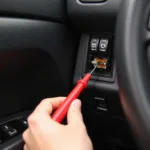Finding reliable information on auto diagnosis service and repair can be challenging. Many car owners and even professionals seek comprehensive resources, ideally in a convenient format like a PDF, to understand complex diagnostic procedures and repairs. This guide explores the intricacies of auto diagnosis service and repair, covering essential aspects from understanding diagnostic trouble codes (DTCs) to utilizing advanced diagnostic tools and finding reputable repair services.
Understanding the Importance of Auto Diagnosis
Accurate auto diagnosis is the foundation of effective vehicle repair. It pinpoints the root cause of a problem, preventing unnecessary part replacements and saving you time and money. A proper diagnosis goes beyond simply reading error codes; it involves a systematic approach that combines technical expertise, advanced tools, and a deep understanding of vehicle systems.
Why Accurate Diagnosis is Crucial
Misdiagnosis can lead to a cascade of issues, including recurring problems, increased repair costs, and even safety hazards. A thorough auto diagnosis ensures that the correct repair is performed the first time, minimizing downtime and maximizing vehicle longevity.
Imagine a scenario where your check engine light illuminates. A quick scan reveals a DTC related to the oxygen sensor. A less experienced mechanic might immediately replace the sensor. However, a skilled diagnostician will investigate further, potentially discovering a vacuum leak or a faulty fuel injector, which are the actual culprits behind the oxygen sensor error.
Utilizing Auto Diagnosis Tools and Techniques
Modern vehicles are complex machines equipped with sophisticated electronic systems. Diagnosing issues requires utilizing specialized tools and techniques.
OBD-II Scanners: Decoding the Secrets of Your Car
OBD-II (On-Board Diagnostics, second generation) scanners are essential tools for retrieving diagnostic trouble codes. These codes provide clues about the potential source of a problem. However, interpreting DTCs requires expertise. A code may point to a symptom rather than the root cause.
Advanced Diagnostic Software: Unlocking Deeper Insights
Beyond basic OBD-II scanners, professional-grade diagnostic software offers access to detailed vehicle data, including live sensor readings, wiring diagrams, and component-specific testing procedures. This software allows technicians to perform in-depth analysis and pinpoint even the most elusive issues.
The Role of Experienced Technicians
While having access to the right tools is crucial, the experience and expertise of the technician are paramount. A skilled technician possesses the knowledge and intuition to interpret data accurately, formulate effective diagnostic strategies, and recommend the appropriate repairs.
Finding Reputable Auto Diagnosis Service and Repair
Choosing a trustworthy auto repair shop can be daunting. Here are some factors to consider:
- Certifications and Affiliations: Look for certifications like ASE (Automotive Service Excellence) and affiliations with reputable organizations.
- Experience and Specialization: Some shops specialize in specific makes or models, providing in-depth expertise.
- Customer Reviews and Testimonials: Online reviews and testimonials can offer valuable insights into the quality of service.
- Transparency and Communication: A reputable shop will clearly explain the diagnostic process and provide detailed estimates.
Auto Diagnosis Service and Repair PDF Resources
While a single PDF may not cover every aspect of auto diagnosis, numerous online resources offer valuable information in PDF format. These resources often include:
- Troubleshooting Guides: These PDFs provide step-by-step instructions for diagnosing common car problems.
- Wiring Diagrams: Detailed wiring diagrams are essential for identifying and tracing electrical faults.
- Component Specifications: These PDFs provide technical specifications for various vehicle components.
Why Professional Auto Diagnosis Matters
Investing in professional auto diagnosis is a proactive approach to car maintenance. It can prevent minor issues from escalating into major repairs, saving you money and ensuring the safety and reliability of your vehicle.
Conclusion
Accurate auto diagnosis service and repair is essential for maintaining the health and longevity of your vehicle. Utilizing the right tools, techniques, and seeking the expertise of qualified professionals ensures that problems are identified and addressed effectively. While finding a comprehensive Auto Diagnosis Service And Repair Pdf can be valuable, remember that practical experience and expertise are crucial for accurate diagnosis and repair.
FAQ
- What does a check engine light mean? A check engine light can indicate a range of issues, from minor sensor malfunctions to serious engine problems. It’s crucial to get a diagnostic scan to pinpoint the cause.
- How often should I get my car diagnosed? Regular maintenance checks often include diagnostic scans. However, if you notice any unusual symptoms, it’s best to get your car diagnosed promptly.
- Can I diagnose my car myself? While basic OBD-II scanners can provide some information, accurately interpreting the data requires experience.
- How much does an auto diagnosis cost? The cost of auto diagnosis varies depending on the complexity of the issue and the shop’s rates.
- What is the difference between a diagnostic scan and a repair? A diagnostic scan identifies the problem, while the repair addresses the identified issue.
- What is preventative maintenance? Preventative maintenance includes regular inspections and servicing to prevent potential problems and extend the life of your vehicle.
- How do I find a reputable auto repair shop? Look for certifications, check online reviews, and ask for recommendations from trusted sources.
Common Auto Diagnosis Scenarios
- Check Engine Light On: This is a common trigger for seeking diagnostic services.
- Unusual Noises: Strange noises from the engine, brakes, or suspension can indicate underlying problems.
- Performance Issues: Reduced fuel efficiency, loss of power, or rough idling can be signs of mechanical or electrical faults.
Related Articles and Resources
- Understanding Diagnostic Trouble Codes (DTCs)
- Choosing the Right Auto Repair Shop
- The Importance of Regular Car Maintenance
Need help? Contact us via WhatsApp: +1(641)206-8880 or Email: [email protected]. Our customer support team is available 24/7.


